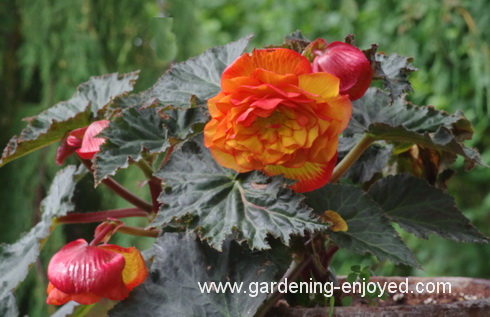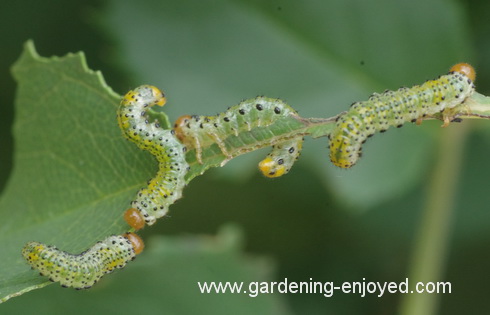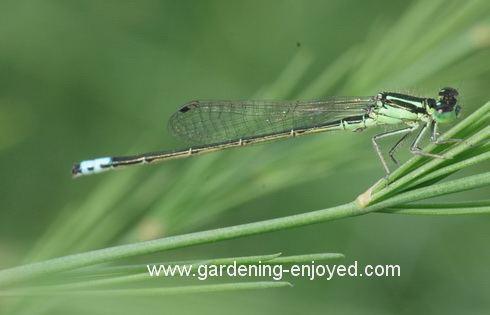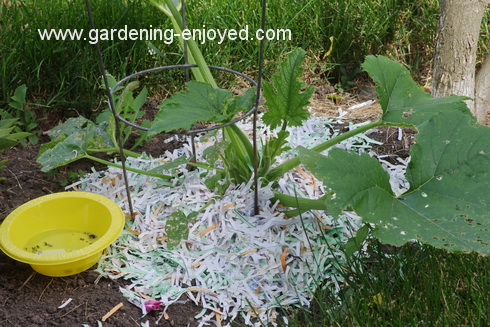
When our local nursery was only doing curbside service I called and asked them to get me about 8 Tuberous Begonia tubers, they are all doing well but this one grew much bigger and faster than the others and has these magnificent flowers. It’s sitting in a large pot on top of the waterfall where it gets sun in the morning but some shade most of the afternoon. The others are all on posts around the deck and are in much more shade and still providing a lovely assortment of blooms in a variety of colours. I would have spent too much time in that store trying to decide which ones to buy.

From the lovely to the not so lovely, although they do have some interesting colouring. These are the larva of the Rose Sawfly and I found them attacking Olivia, how dare they. A good blast with the insecticidal soap and they were nowhere to be seen the next morning. Sharing their space was another Rose Sawfly that has a fat curled larva that doesn’t seem quite as voracious an eater but likes to also munch on the flower buds. A good soaping and it is gone as well. There seems to be an abundance of bugs this year and many of them are beneficials so we have to be careful who we spray. One of the advantages of the insecticidal soap is its need to be sprayed directly on the creatures and it has no residual effect so the good guys can’t wander onto it later. Of course that means that we have to continue to be vigilant. Picking up that spray bottle and wandering the garden is my first activity each morning. It’s a gentle activity, at least for me if not the bugs, and it is
very effective.

Not all bugs are bad or ugly. This lovely Damselfly eats about 30 mosquitoes a day and that in itself makes her beautiful. There are two or three different species of these delicate delights constantly flying and perching in the Asparagus plants. That’s just a couple of metres from the ponds where they likely spent their teenage years as aquatic larva. Their interest in the Asparagus is a mystery. They eat other insects and catch them while flying. They mate and lay eggs in or near the water so why are they spending so much time in the Aspargus unless it’s just a nice place to rest between hunting expeditions. I enjoy watching them as I search the Asparagus for the Beetles that want to devour it. It does make me aim my spray bottle very carefully to avoid hitting any of those Damselflies. Now if I could just train them to eat Asparagus Beetles??

The Assistant Gardener comes to the rescue, I hope! I have always avoided using any mulch in the vegetable garden because of having to deal with its remains the next spring. The Yellow bowl is catching lots of Cucumber Beetles but it also attracts the larger Squash Vine Borer. Mulching the base of the various Squash vines like my Zucchini, Squash, Melons and Cucumbers is supposed to be a good way to prevent them from laying their eggs at the base of those plants. Enter the Assistant Gardener and the shredded paper from her office. A nice light weight but dense mulch that will, hopefully, be totally decomposed by next spring’s planting time. Now if it actually works to keep away that Borer it will be the best recycling project yet.

On the 27th of May in “Dallying” issue # 363 I showed you a picture of the well planned fence bed. The Colchicum spring foliage was in its prime and the Heavy Metal grass was just starting to emerge. I mentioned that the Assistant Gardener was painting the fence and she did point out to me that I had chosen an unpainted section to photograph. That oversight has obviously been corrected and she has finished the fence. The Colchicum and Heavy Metal grass have reversed positions. The former foliage has performed its bulb building function and is heading for its summer vacation while the grass is rapidly taking over that space and making it a decorative but low maintenance feature that helps to make the painting job look even better. The planning continues to work well, something that doesn’t always happen here.
To ask a question just “reply” to this ezine. Don’t forget to check the
front page of the Website for frequent short ideas for current gardening activities.
Lorne Asks? Thanks for a great blog! Our privet hedge is very old and very large and very healthy. Can we cut it right down next spring and expect it to grow again? Thanks!
Ken Answers!I have no experience with rejuvenating a privet hedge so I'm not going to offer an opinion in case I’m wrong and you lose the hedge altogether. Does anybody else have a better answer for Lorne?
Shirley Asks? My question is about the Oriental poppies' 'beastie'. Having grown the strong-stalk types only for one year, I had no idea what had distorted the blooms. However, since then I realize it is the 'Tarnished plant bug'. I have never seen them, nor any larvae, but the damage is certainly there to be seen.
A dusting of 'sabadilla' was recommended, but have also read that the dust is
somewhat toxic. Even if I use it with caution, where to find it in Canada? Spraying with Pyrethrum laced with isopropyl alcohol was also recommended, but think this is for spraying the actual pest or larvae, neither of which I've seen - even early in the morning.
Ken Answers!Tarnished plant bug likes to eat a wide variety of ornamentals as well as vegetables and is somewhat difficult to control. Prevention through row covers and good cleanup procedures would seem to be your best bet. Sabadilla is no longer available or recommended in Canada.
|





